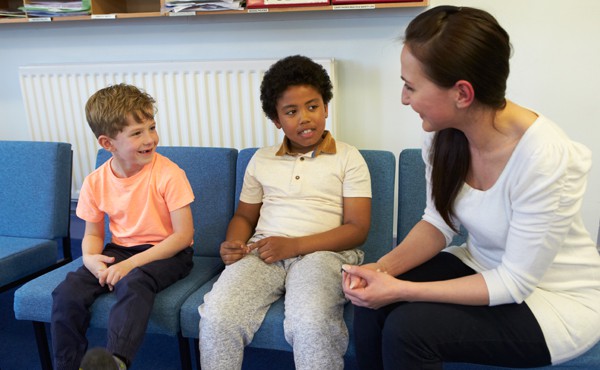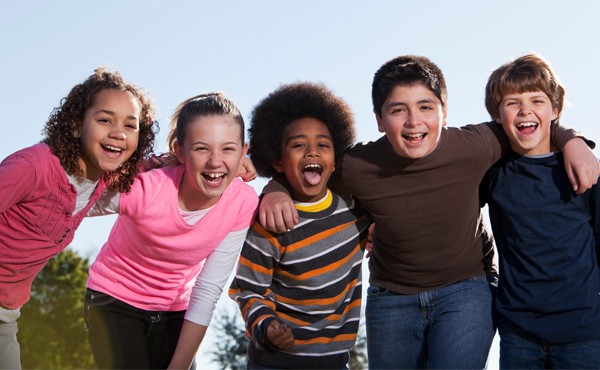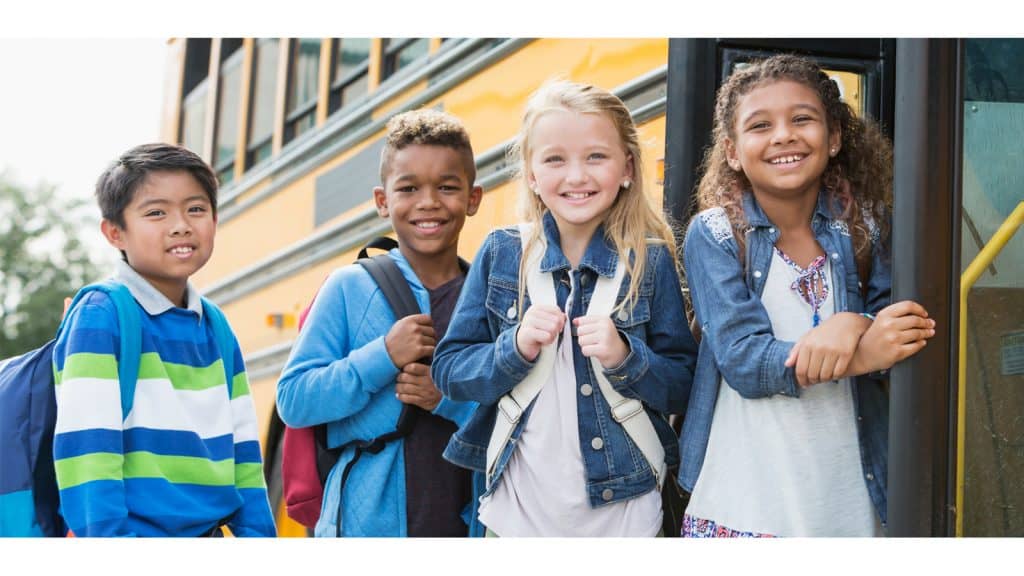Conflict: It’s great for drama, and an inescapable part of human progress, but it can make for fraught situations in the classroom.
Conflict can happen even in the most supportive, positive, and open classrooms, disrupting your students’ ability to learn. If left unchecked, it could even lead to violence.
Many districts may offer some type of conflict resolution training. Even if yours doesn’t, the good news for educators who are caught in the middle of classroom conflict is that there are many options for conflict resolution.
This article discusses strategies for dealing with conflict between students, as well as with an angry, disruptive student. And because conflict resolution is part of a child’s social and emotional development, we’ve included a few activities to help teach conflict resolution skills in the classroom.
Conflict Resolution Steps to Help Students Grow
Ask 100 people what conflict resolution is, and you’ll probably get 100 different answers. But there are concrete steps you can take to settle problems in the classroom. Not every conflict will be the same, and so not every conflict can be resolved in the same manner. But understanding basic strategies can help most situations.
Depending on the situation, there are several different options for conflict resolution. Here are some examples.
Conflicts Among Students
 Sometimes the spark that ignites conflict seems simple, like interrupting another student or using someone else’s property without permission. While these types of conflicts may be small-scale, researchers have found that violence can stem from relatively small conflicts, so handling disputes quickly is paramount.[3]
Sometimes the spark that ignites conflict seems simple, like interrupting another student or using someone else’s property without permission. While these types of conflicts may be small-scale, researchers have found that violence can stem from relatively small conflicts, so handling disputes quickly is paramount.[3]
When something comes up, educators should take time to SOAR: Stop, Observe, Assess, and React.[6] Then you can acknowledge the emotions in the room and use the situation as a learning opportunity.
In cases where there’s been a larger conflict between two students, here are six steps teachers can use to help students resolve a dispute:[4]
1. Cool off
First, before problem-solving can begin, the students need time to calm down. For younger students, have them take some deep breaths.
2. Share, listen, check
Students need to listen to each other share their issues, and then check that they understand them. This can take practice and coaching from a teacher. When sharing, students should use respectful but assertive “I statements,” like “”I feel sad when you don’t let me play because I am alone.” Students can work on reflective listening and paraphrasing when they check for understanding. For example, they can start sentences with “I think I heard you say you feel …” or “So you want me to try to …”.
3. Take responsibility
Once students have shared their perspectives, they need to take responsibility for their own actions. You can prompt students by asking them an open-ended question like, “What could you have done differently to change what happened?”
4. Brainstorm solutions
Now the students can work together to find a solution that’s acceptable to both. This is a good time for students to learn to compromise. It can be helpful for a teacher to start the discussion with some suggestions, but it’s best that the ideas come from the students.
5. Choose a solution
Students now go over their brainstormed list of solutions to eliminate the ones that aren’t good for both of them and ones that won’t address future problems.
6. Affirm, forgive, or thank
Students can close out the session by acknowledging what happened and forgiving the other student (if an apology or forgiveness is warranted). They can then thank each other for working on the solution together.
Helping An Angry Student
Sometimes an educator needs to deal with a student who’s angry and causing a disruption in the classroom. York University in Canada has the following suggestions for such a case:[2]
Stay calm and polite and keep your own emotions under control. Keep eye contact and speak clearly—without raising your voice. (Note that some cultures may view eye contact as confrontational. Other non-verbal cues that show you are paying attention may be helpful.)
Offer to talk privately during a break in class, or to go to a quieter place if it’s safe. Acknowledge the student’s anger and let them vent to you about what is upsetting them. Listen and try to understand the real issues that are concerning the student. During your conversation, summarize and clarify your understanding of what the student has said. Don’t disagree with the student, but build on what they have said.
You can help the student by giving them a way out—letting them gracefully back down from a heightened situation. This can be done again with open-ended questions that help the child calm down and understand what actually frustrated them in the first place.
Finally, encourage your student to generate solutions to the problem being addressed. Restate and reassure the child when they present a reasonable solution to the conflict.
Conflict Resolution Activities and Games for Children
Learning how to handle disagreements and conflict is a critical part of social-emotional learning (SEL). Social skills like cooperation, empathy, and self-control are integral to emotional development and conflict resolution.[1] Helping students develop strong social-emotional learning skills and build the competencies laid out by the Collaborative for Academic, Social, and Emotional Learning (CASEL) can strengthen children’s intellectual development, leading to lifelong success.
 Incorporating fun activities and games in the classroom can help teach essential conflict resolution and social-emotional skills to children.
Incorporating fun activities and games in the classroom can help teach essential conflict resolution and social-emotional skills to children.
One place to start is simply by reading. Read-alouds can prompt class discussions about empathy, different perspectives, and the virtues of patience. Regular reading and discussion about these themes, and how they relate to real-world conflict resolution, can help children build their ability to handle conflicts.[5] Children may also benefit from coming up with other ways for characters to handle situations in the books.
Group activities like role playing help children understand differing perspectives, while also being fun for the class. When they’re put in a situation and portraying something different from what they’re used to, children learn empathy and practice considering other peoples’ points of view. For younger students, it can be helpful to have a discussion after the role play to remind them they were playing a different “character,” and to ensure students learned from the fun activity.[3]
When conflict arises, having the students involved write or draw a picture about what happened can be helpful for several reasons.[6] First, it sets a cooling-off period. It also encourages them to reflect on what happens and how it made them feel. Teachers can help students consider their actions by prompting them with questions like, “What would you choose to do differently?” or “How did this make you feel?”[3]
No two situations are the same, but generally these strategies can help create a peaceful and constructive classroom. When you’re dealing with any level of conflict, remember that the goal is not just to end the argument, but to use the situation to help empower students to grow and learn how to solve their own problems.
Sources:
- Responsive Classroom. “A Conflict Resolution Protocol for Elementary Classrooms.” March 2001. https://www.responsiveclassroom.org/a-conflict-resolution-protocol-for-elementary-classrooms/
- Teaching Commons at York. “Managing Conflict in the Classroom.” York University. https://teachingcommons.yorku.ca/resources/teaching-strategies/managing-conflict-in-the-classroom/
- The Resilient Educator. “4 Effective Conflict Resolution Strategies in the Classroom.” April, 2018. https://resilienteducator.com/classroom-resources/4-effective-conflict-resolution-strategies-in-the-classroom/
- Driscoll, Laura. “Teaching Conflict Resolution Skills in 6 Easy Steps.” Social Emotional Workshop. October, 2017. https://www.socialemotionalworkshop.com/2017/10/teaching-conflict-resolution-skills/
- Curletto, Amy. “Quick & Effective Conflict Resolution Strategies for the Classroom.” Stanfield.com. https://stanfield.com/quick-effective-conflict-resolution-strategies-for-the-classroom/
- Center for Teaching Innovation. “Getting Started with Managing Classroom Conflict.” Cornell University. https://teaching.cornell.edu/resource/getting-started-managing-classroom-conflict

